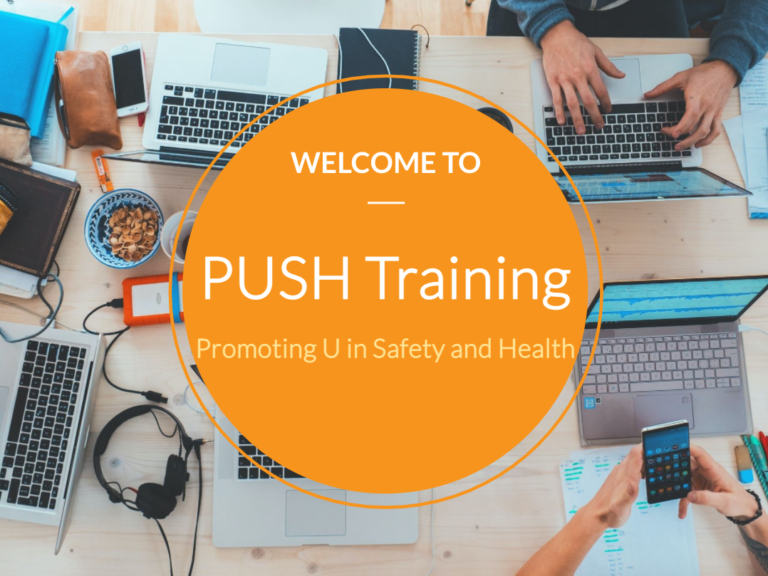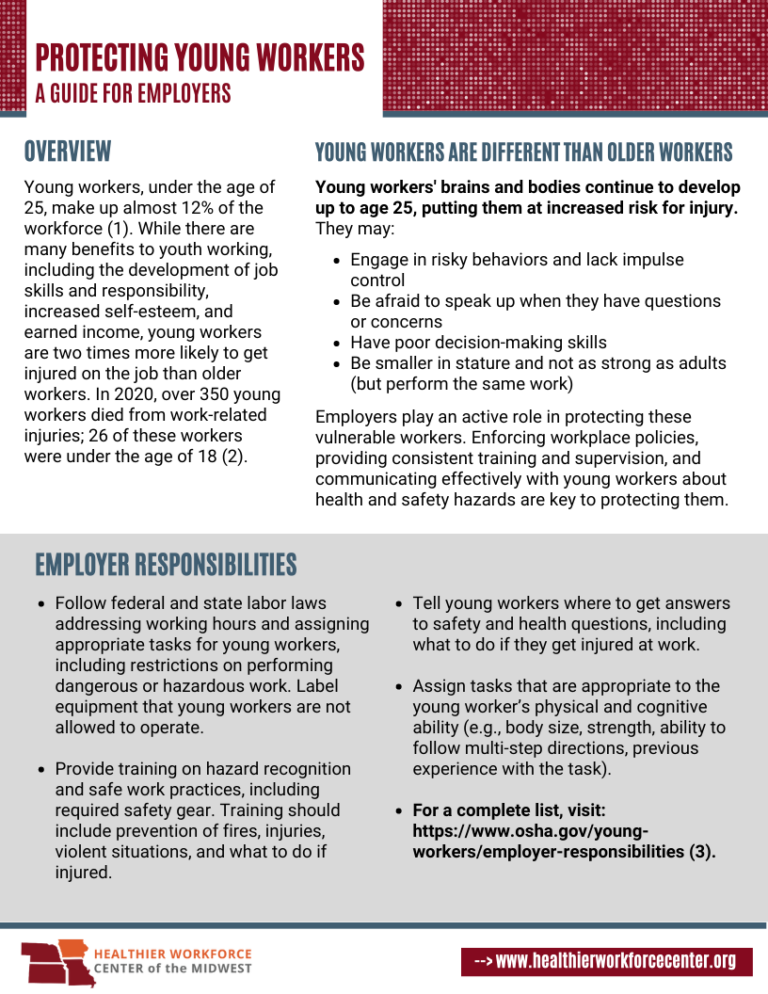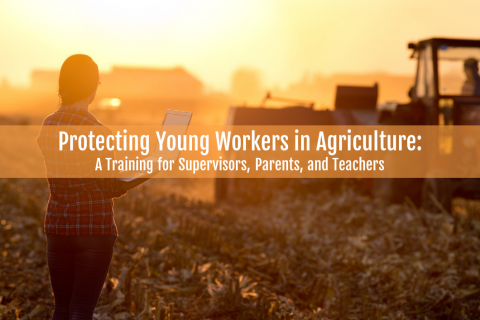In this episode of Workplace Matters we are talking with Healthier Workforce Center Director, Dr. Diane Rohlman about the health, safety, and well-being of young workers.
Dr. Rohlman explains why youth are vulnerable, and how employers can effectively train and communicate with young workers to protect their health and ensure a safe workplace.
Michael: You’re listening to Workplace Matters. Young workers face risks to their safety, health, and wellbeing. As they join the workforce the employers who hire them need to be aware of these risks and what can be done to protect them.
INTRO MUSIC
Diane: So young workers, we think of up to the age of 25. So it’s not just adolescence, it’s not just 18. It’s up to the age of 25 because your bodies and brains are still developing up to the age of 25.
Michael: Diane Rohlman is the director of the Healthier Workforce Center of the Midwest, and Associate Dean of Research for the University of Iowa College of Public Health.
Diane: Young workers are two times more likely to get injured than older adults. When we think about protecting young workers, we think about the traditional hazards in the workplace. Same thing every worker faces chemical exposures falling from heights on guarded machinery, noise. With young workers, we have other factors. The fact that their bodies and brains are still developing is a big factor. So, they’re less likely to think that doing something harmful is going to impact them in the long term. Another factor is inexperience. And that’s a really important one because some people who come to your workplace may have never worked in a job before.
Michael: Beyond being at a higher risk for injuries, young workers are at a key point in their lives for developing healthy behaviors.
Diane: During adolescence and young adulthood. That’s when we start to develop habits. These include things like our sleep habits, eating habits, physical activity. And if you think about all of those things, they can lead to chronic health conditions. And if we can build those habits early in life, we’re going to help prevent some of those diseases like diabetes, cancer, obesity, heart disease. When you’re tired, when you’re dehydrated, when you’re hungry, that’s when you’re going to start to make mistakes in the workplace. So, we want to make sure that our young workers come to work, ready to work, and they go home healthy.
Michael: Employers need to notice and act when unhealthy behaviors are present. For example an employee who looks tired should not be asked to perform a potentially hazardous task. It is incumbent upon the employer to notice these signs, and act accordingly. Another health behavior not yet mentioned is substance use.
Diane: You know, as you move into later adolescence and early adulthood, that’s when you start experimenting with things. You maybe are staying up late, trying new things. You may be experimental with different substances like alcohol and, with their busy schedules and everything that’s going on in their lives, when you add all of these factors together, you may have some of these young workers showing up at work, maybe not ready to work. And so, a check in every day is really important. And you want to assess how are they doing? Are they ready to do the job that they’re supposed to do and are they able to do it safely? And if they’re not, then you want to think very carefully about reassigning work or if need be, if the policy is in place, sending them home for the day, having a clear message about coming to work, ready to work is important to protect the safety not only of the young workers, but everybody in the workplace.
Diane: Depression is an issue we’re hearing a lot about our young workers. We’re seeing very high rates of deaths by suicide in this population. And that’s concerning. And some of those factors that contribute to that could be mental illness, which often develops during adolescence. But they can also be workplace factors. And we want to think about how we can support them and create a workplace that allows them to be engaged in work but also have a healthy life.
Michael: To help a young employee dealing with depression or anxiety, referring them to professional help through an EAP or mental health service is best, but simply asking them “are you okay” does much more than saying nothing.
These workers need to be protected as their bodies and brains are developing. Negatively affecting that process could impact their entire life. Dr. Rohlman has specific recommendations on how to protect young worker being.
Diane: One good technique that we have used is called the teach back method. This is a great way to train people. The teach back method is where you start by first showing them how to do the task and you talk it through them. The next thing you do is you ask them to tell you how to do the task and they repeat it back and you can correct them at this time. And then finally you watch them do the task. It’s a great opportunity to make sure they have it correct. They’ve explained how to do it and you’ve also seen them do it. You want to create a culture where they’re comfortable coming to you, where they can talk to you and tell you if something went wrong, if they broke the equipment or they don’t remember how to do something. And that can be done a couple of different ways. It could be, you know, training supervisors on how to ask questions and how to check in.
Michael: Checking in and asking questions may sound simple, but open ended questions are most effective.
Diane: If you ask them, “do you know how to do this task?” they’re going to say, “Yeah, of course.” Or. “Mm hmm”. And that’s really not going to assess whether or not they know how to do it. So, you want to switch the question a little bit. “What do you think are the most difficult parts about this task and how would you handle them” or “what happens if something goes wrong, or you run into a problem. What’s the procedure you’re going to use to address that?”
Michael: It is also vital that young workers observe their supervisors role modeling safe and healthy behaviors.
Diane: So, if you’re telling, your young workers to wear a seatbelt, to not use their cell phone when they’re in the operating a piece of equipment you don’t do those, they’re not going to do it. So, you need to role model the behaviors you want to see in your workers, whether it’s wearing the seatbelt or wearing the personal protective equipment, drinking water when it’s hot out, taking breaks, even not checking your email in the middle of the night.
They’re low-cost solutions, things you can do. You may need to invest in training your supervisors and looking at your policies too.
Michael: Many of these recommendations can be applied to other workers, but they are particularly important for young workers who may have not had the work experience, nor the time for their bodies and minds to fully develop.
Diane: Workplace injuries can often lead to a permanent disability that can have a lasting impact on somebody’s life. So, if somebody is injured when they’re 15, that may limit what they can do as they get older and their potential earning and their ability to be successful in their life.
Michael: Workplace Matters is supported by the national institute for occupational safety and health. To listen to more podcasts, view our ongoing video series, or for more information about us, visit HealthierWorkforceCenter(dot) org. Thank you.
The Workplace Matters podcasts are located here.

The PUSH online training is a 50-minute, self-paced program that uses videos and real-life examples to teach young workers about safety, communication, and health.

This employer guide outlines strategies for protecting the health, safety, and well-being of young workers.

A free, evidence-based training developed for supervisors, parents, and teachers. Topics include supervising, training, and communicating more effectively with young workers.
